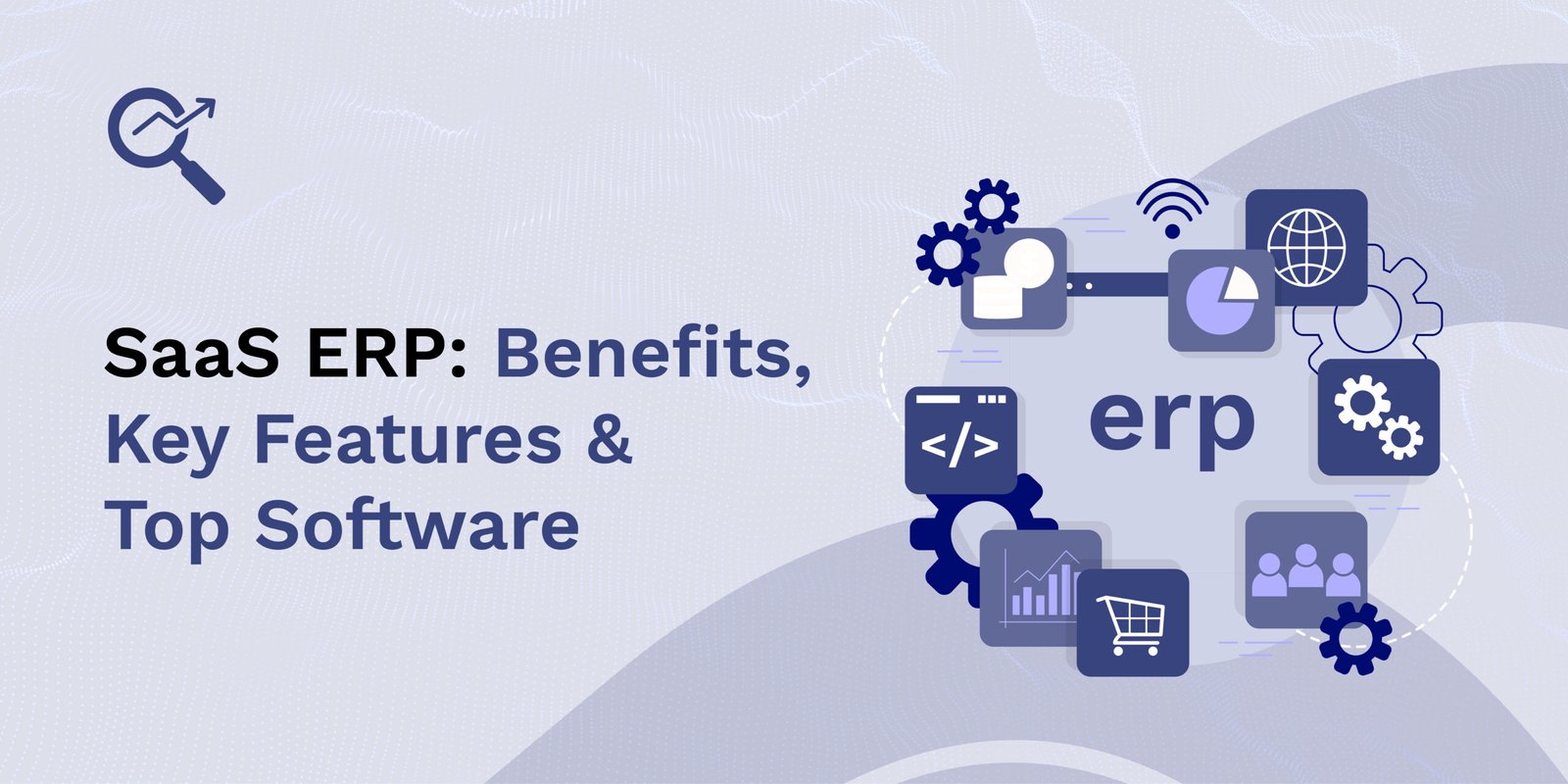Running a business is not easy. You have to manage sales, inventory, customers, accounts, and so much more. That is where ERP software comes in. It helps businesses handle everything in one place.
Now, in 2025, SaaS ERP has become very popular. It is cloud-based, you do not need to install anything. You just log in and start working from anywhere.
In this blog, we will explain what SaaS ERP is, why it is useful, what features you should look for, and which tools are the best in 2025. Whether you run a small company or a growing one, this guide will help you understand how SaaS ERP can make your work easier and faster. Let’s get started.
What is SaaS ERP?
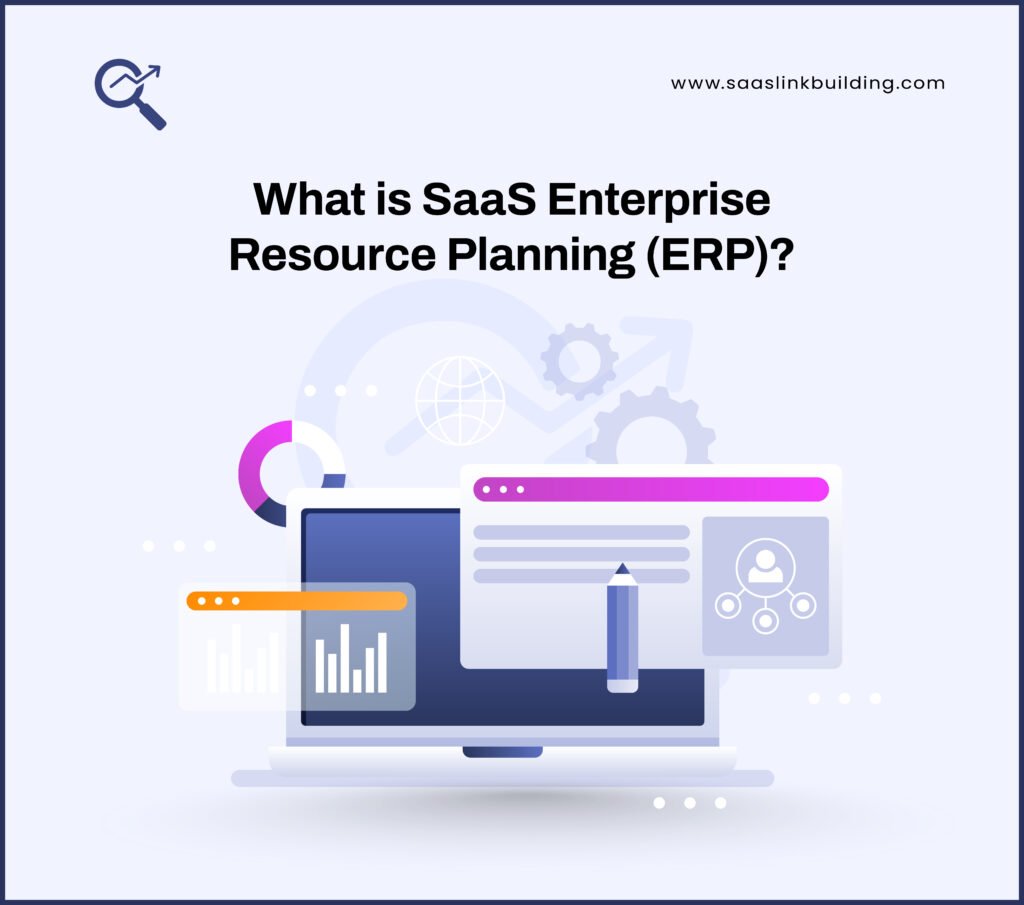
SaaS ERP (Software as a Service Enterprise Resource Planning) is a cloud-based system that helps businesses manage everything from accounting and inventory to HR and sales—all from a single platform that runs online.
Unlike traditional ERP software that’s installed on company servers, SaaS ERP lives in the cloud. That means:
- You don’t need to buy heavy hardware
- Updates happen automatically
- Your data is accessible anytime, anywhere
- You only pay for what you use, usually with a monthly or annual subscription
In simple words: SaaS ERP is modern ERP made flexible, affordable, and stress-free.
Why Should You Care?
If you’re running a business in 2025, there’s a high chance you’re juggling multiple tools—Excel sheets, CRMs, billing software, HR platforms. That’s messy and time-consuming.
Here’s why SaaS ERP should be on your radar:
- It saves time by centralizing your processes
- It saves money by cutting down IT costs and manual errors
- It gives you insights with real-time reports and dashboards
- It scales with you—whether you’re a 10-person startup or a 500-person company
- It supports remote work so your team stays productive anywhere
In short, SaaS ERP helps you do more with less, and keeps your business agile, especially in a digital-first world.
Benefits of SaaS ERP
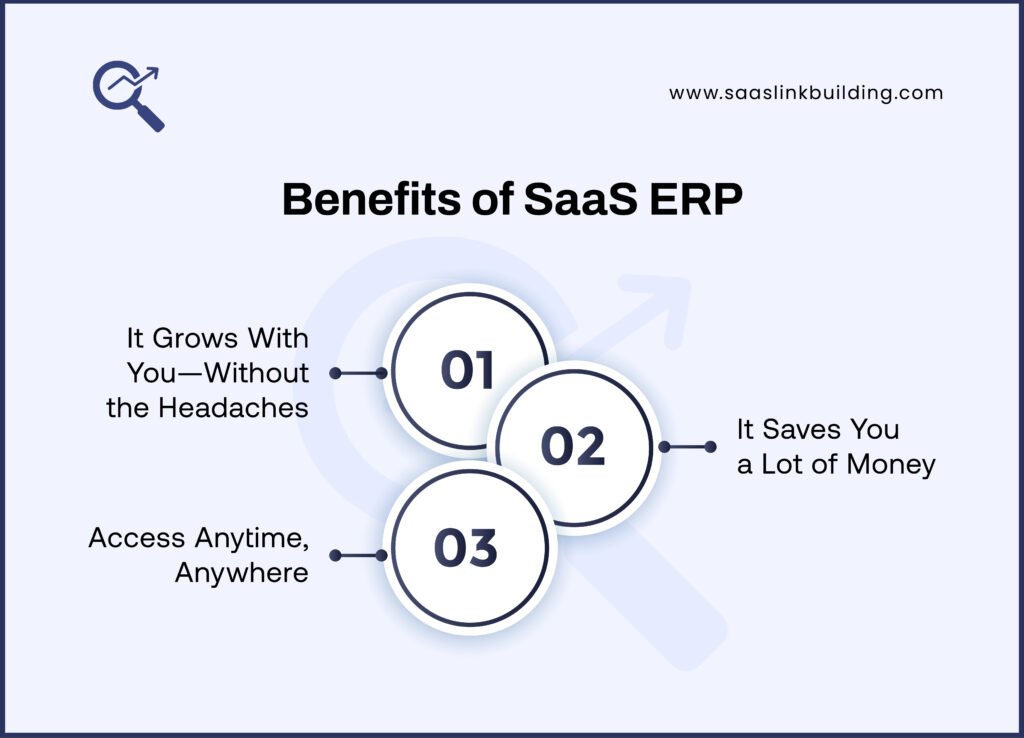
If you’ve ever used a traditional ERP system, you probably know the pain—long installations, heavy costs, and constantly needing IT help just to make simple changes. SaaS ERP fixes all that. It’s ERP built for how we work today: fast, flexible, and online.
Let’s talk about what really makes it worth switching.
It Grows With You—Without the Headaches
Businesses don’t stay the same. One month you’re a team of five, the next you’re handling new clients, hiring more people, or expanding to new markets. Traditional ERP? Not great at keeping up.
SaaS ERP, though, is built to scale. You don’t need to buy new hardware or wait weeks for custom setups. You just upgrade your plan or add users, and you’re good to go.
It’s like Netflix for your business systems—you only pay for what you need, and you can change it anytime. That kind of flexibility is gold, especially for growing companies that don’t want to get locked into something bulky or outdated.
It Saves You a Lot of Money (and Stress)
Let’s be real—traditional ERP systems are expensive. Between the upfront software costs, hardware, setup, and hiring IT staff to manage it all, the price tag can get out of control fast.
With SaaS ERP, you skip all that. It runs on the cloud, so there’s no need to buy servers or pay someone to babysit the system. Updates? Done automatically. Maintenance? Handled by the provider. All you need is an internet connection.
You basically get enterprise-level software without the enterprise-level price. And for small or mid-sized businesses trying to stay lean, that’s a huge win.
Access Anytime, Anywhere (Even From a Café)
One of the best parts of SaaS ERP? You don’t need to be in the office to use it. Whether you’re working from home, traveling, or sipping coffee at a local café, you can log in and get a full view of your business.
Want to check inventory? Done. Need to approve an invoice? Click. Everything updates in real time, so you’re never out of the loop—and neither is your team.
That kind of instant access to real-time data helps you move faster and make better decisions. No delays, no guesswork, no outdated spreadsheets floating around in email chains.
Why It Just Makes Sense
To sum it up:
- It grows with your business—no more painful upgrades.
- It cuts costs—goodbye to hardware and IT chaos.
- It gives you freedom—work from anywhere, anytime.
SaaS ERP isn’t just about using modern software—it’s about running your business smarter and staying ahead without getting buried in tech.
Top SaaS ERP Software in 2025: Features & Use Cases
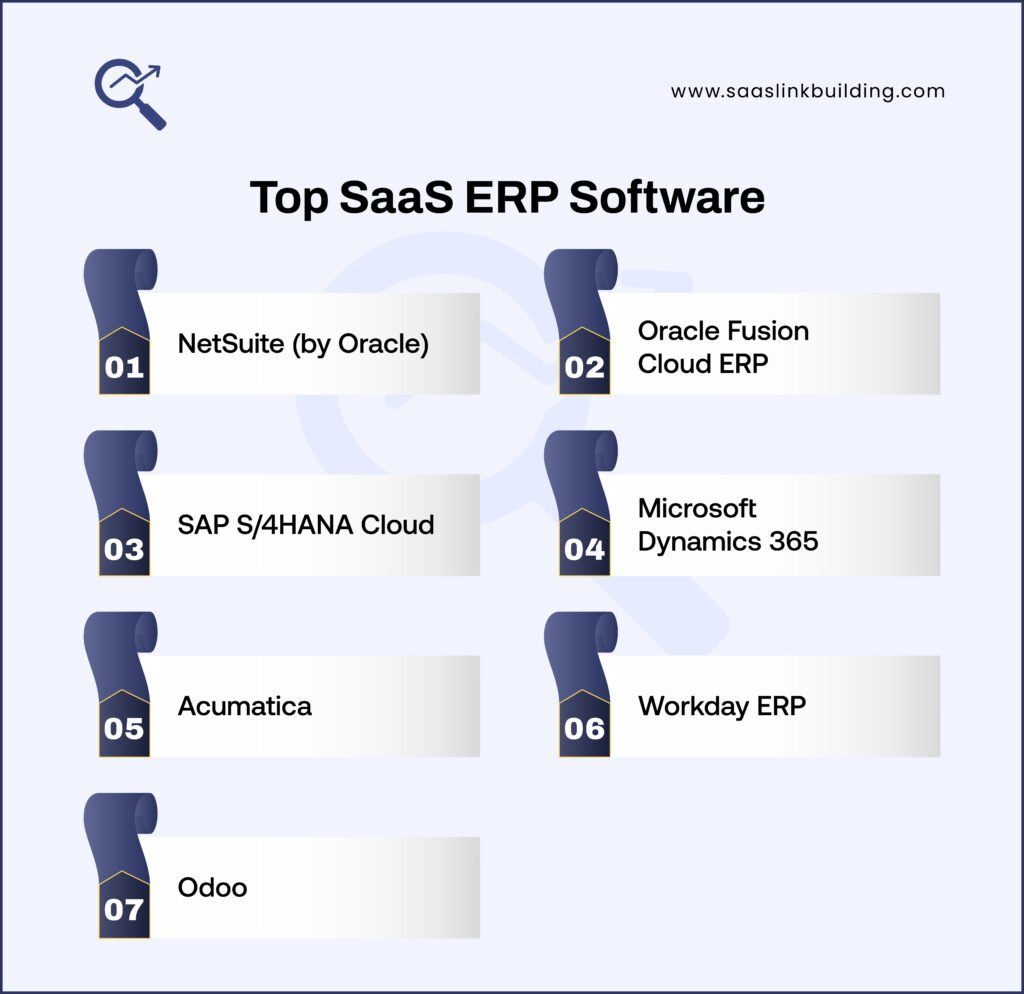
Choosing the right SaaS ERP software isn’t just about going with a popular name—it’s about finding a system that actually fits your business model, team size, and goals.
Here’s a curated list of the best SaaS ERP platforms in 2025, backed by industry reputation, customer satisfaction, and real-world performance. Whether you’re a startup or a large enterprise, this comparison will help you make a more informed decision.
1. NetSuite (by Oracle)
NetSuite has been a pioneer in the cloud ERP space. In 2025, it’s still one of the most widely used platforms, especially for businesses looking for strong financial management, inventory tracking, and CRM integration.
- Best for: Mid-sized to growing enterprises
- Key Features: Financials, eCommerce, CRM, supply chain, HR
- Pricing: Starts around $999/month + $99/user/month (custom pricing for large teams)
- Why Choose It: Highly scalable, global compliance features, strong reporting capabilities
2. Oracle Fusion Cloud ERP
Oracle’s own cloud-based ERP solution, Fusion Cloud ERP, is designed for big players. It’s known for AI-driven analytics, advanced financials, and enterprise-grade customizations.
- Best for: Large enterprises with complex operations
- Key Features: Financials, procurement, risk management, AI insights
- Pricing: Custom enterprise pricing
- Why Choose It: Powerful for finance-heavy businesses, great for global companies with complex compliance needs
3. SAP S/4HANA Cloud
SAP’s cloud ERP, S/4HANA, continues to dominate sectors that rely on real-time supply chain management and detailed manufacturing workflows. It offers both public and private cloud deployment options.
- Best for: Manufacturing, retail, and multinational businesses
- Key Features: Manufacturing, supply chain, logistics, AI-powered insights
- Pricing: Based on modules and user count (custom pricing)
- Why Choose It: Excellent for large-scale operations and industry-specific needs
4. Microsoft Dynamics 365
Dynamics 365 combines ERP and CRM in one smart cloud solution. It works seamlessly with Office 365, Teams, and Azure—making it a natural fit for companies already using Microsoft tools.
- Best for: Businesses already in the Microsoft ecosystem
- Key Features: Finance, operations, sales, customer service, marketingPricing: Starting
- Pricing: Starts at $180/user/month (varies by module)
- Why Choose It: User-friendly, strong integrations, AI-powered forecasting
5. Acumatica
Acumatica stands out for its user-friendly design, open APIs, and flexible pricing model. It’s ideal for companies looking for an agile ERP that won’t break the bank.
- Best for: Small to mid-sized businesses with growing needs.
- Key Features: Project accounting, CRM, inventory, field service
- Pricing: Based on resource usage, not per user (affordable for growing teams)
- Why Choose It: Budget-friendly, highly customizable, mobile access
6. Workday ERP
Workday is known for its strengths in human capital management (HCM) and finance. Many large institutions and universities use it for payroll, HR, and budgeting.
- Best for: HR-heavy organizations, education, and nonprofits.
- Key Features: HR, payroll, talent management, analytics
- Pricing: Enterprise-level pricing; typically starts from $100K+ annually
- Why Choose It: Best-in-class for HR, seamless user experience, strong mobile UI
7. Odoo
Odoo is open-source, affordable, and incredibly flexible. It offers over 30 core business apps covering everything from accounting to manufacturing, and you can pick only what you need.
- Best for: Startups and businesses that need modular ERP.
- Key Features: Modular apps (CRM, sales, MRP, inventory, accounting)
- Pricing: Starts at $31.10/user/month (plus cost per app/module)
- Why Choose It: Affordable entry point, customizable, community support
How to Choose the Right SaaS ERP for Your Business
No two businesses are the same, and your ERP shouldn’t be a one-size-fits-all decision. Focus on:
- Your business size and growth plans
- Key pain points you need solved
- Budget flexibility
- Must-have features vs. nice-to-haves
- Integration with your existing tools
If you’re just starting out, Odoo or Acumatica could be perfect. For scaling teams, NetSuite and Dynamics 365 offer balance. For enterprise-level complexity, Oracle and SAP are top-tier.
💡Choosing the right SaaS ERP is just one part of building a successful SaaS operation. But to really scale your software business in 2025, you also need a strong SaaS marketing foundation. From SEO and content to link building and outreach—marketing is what fuels your growth engine.
👉 Explore this complete SaaS marketing guide to learn how you can attract better leads, improve visibility, and convert more users.
Key Features of SaaS ERP Systems
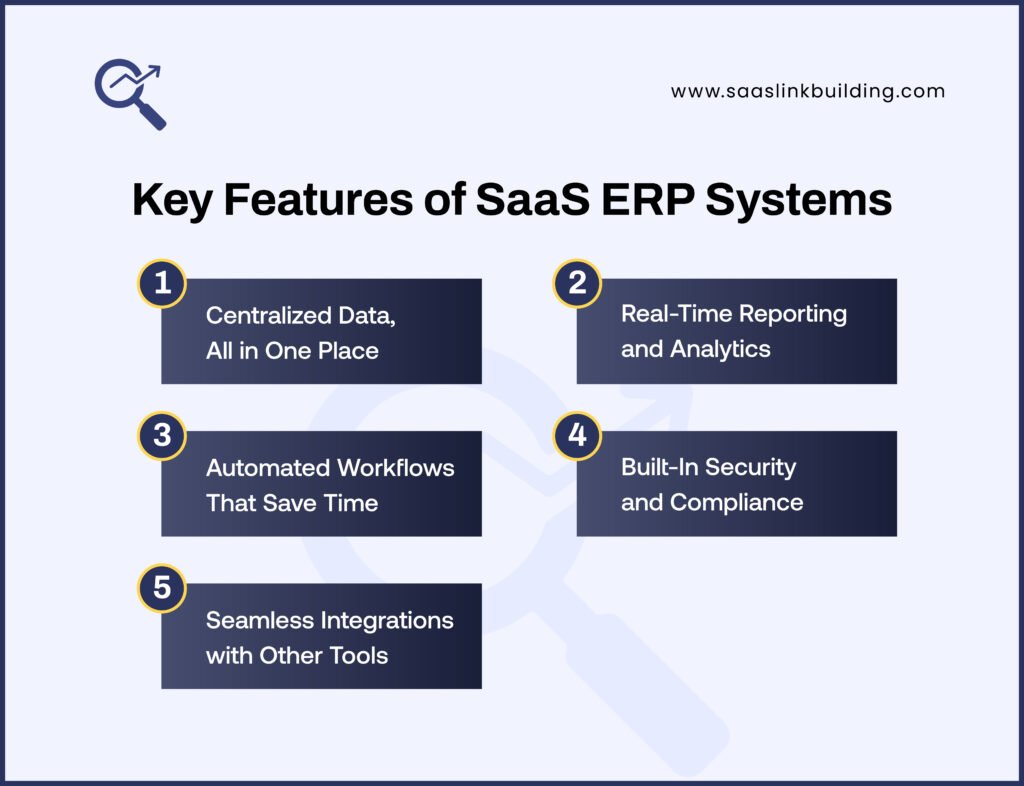
So, what actually makes a SaaS ERP system worth the switch? It’s not just the “cloud” label—it’s the tools, the design, and the way everything works together to help you run your business smoother. Here’s a breakdown of the core features that really matter.
1. Centralized Data, All in One Place
SaaS ERP systems bring all your key business data into one dashboard. Whether it’s sales, inventory, HR, or finances—you’re not jumping between different tools or spreadsheets anymore.
This centralized approach means less confusion, fewer errors, and way better visibility. Everyone—from your accountant to your warehouse manager—is looking at the same, up-to-date information. It’s a game-changer for businesses tired of working in silos.
2. Real-Time Reporting and Analytics
One of the underrated superpowers of a good SaaS ERP? Real-time insights.
You’re not waiting until the end of the week (or month) to see what’s going on. Need to know how sales are doing today? Or which product is running low in stock? You get answers instantly. With built-in reporting and dashboards, you’re always in the know—which makes decision-making faster and way more confident.
This is especially useful if you’re trying to scale or manage multiple teams. You don’t have to rely on “gut feeling”—you’ve got actual data guiding your next move.
3. Automated Workflows That Save Time
Repetitive tasks are productivity killers. Manually entering invoices, managing approvals, tracking leave requests—these things eat up hours. SaaS ERP systems let you automate the boring stuff, so your team can focus on what actually moves the business forward.
From setting up approval chains to scheduling inventory checks or auto-generating reports, automation cuts out the busywork, reduces errors, and makes operations run like clockwork.
4. Built-In Security and Compliance
Worried about data breaches or compliance issues? You should be—and SaaS ERP providers get that. Most top platforms follow industry-standard security protocols, offer data encryption, and are compliant with major regulations like GDPR or SOC 2.
That means your business data stays safe, backed up, and protected—even if your team is working remotely. And since the ERP provider handles all updates and patches, you’re not left scrambling if a new security threat pops up.
5. Seamless Integrations with Other Tools
SaaS ERPs play nicely with others. Whether you’re using a CRM like Salesforce, a payment system like Stripe, or project tools like Slack or Trello—integration is usually smooth and quick.
This flexibility means your ERP becomes the center of your tech stack, pulling in and pushing out data exactly where you need it. No more importing CSV files every week. Everything just… syncs.
What Makes a Strong SaaS ERP?
A great SaaS ERP is more than just software—it’s your business command center. Look for these must-have features:
- Unified data access
- Real-time analytics
- Workflow automation
- Enterprise-grade security
- Easy integrations
These features don’t just sound nice—they solve real problems. And that’s what makes SaaS ERP such a powerful move for businesses in 2025 and beyond.
Integration with Existing Systems: Why It’s a Deal-Breaker (or Maker)
Your ERP system isn’t the only software your business runs on. You probably already use tools like a CRM to manage leads, an HRM system for payroll, or accounting software to handle your books. So when you bring in a new SaaS ERP, it has to play well with others.
If your ERP doesn’t integrate smoothly, your teams will end up switching between platforms, manually entering data, and wasting hours fixing sync errors. That’s not digital transformation—that’s digital chaos.
Connecting SaaS ERP with CRM, HRM & Other Business Tools
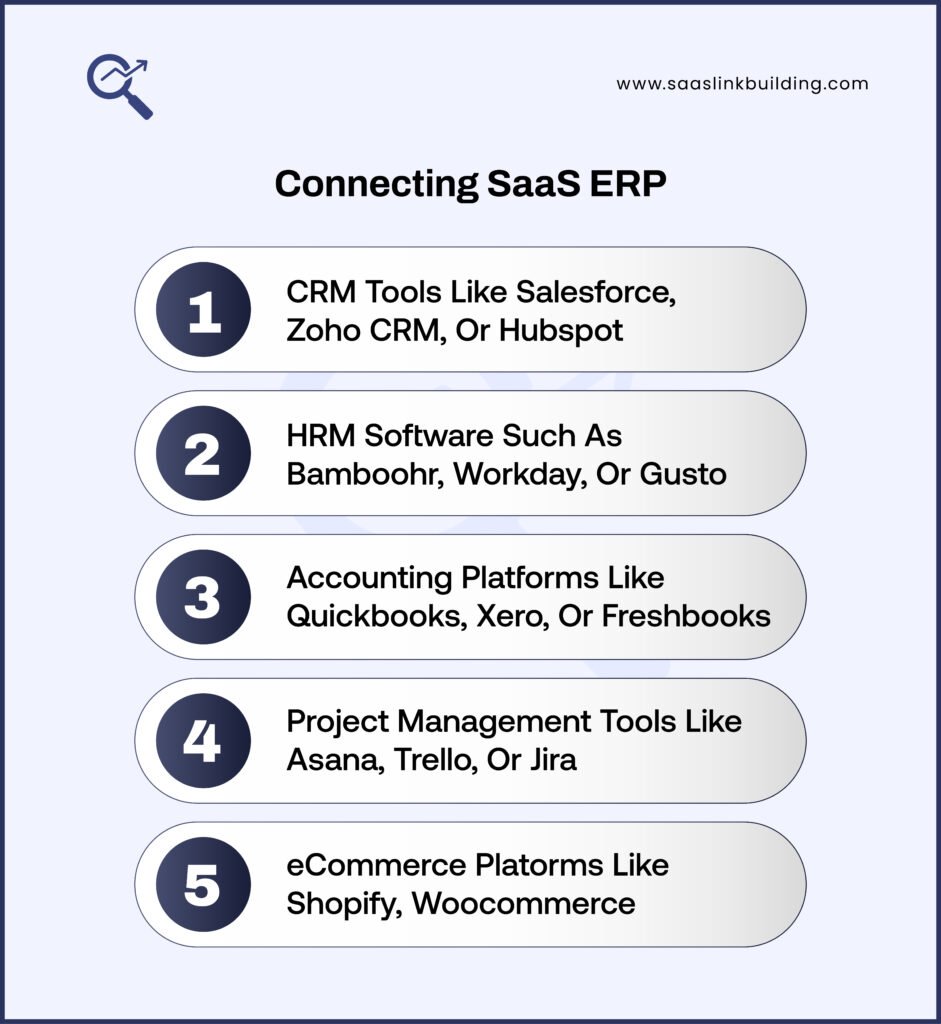
A good cloud ERP system should connect effortlessly with the software you already use daily. This includes:
- CRM tools like Salesforce, Zoho CRM, or HubSpot
- HRM software such as BambooHR, Workday, or Gusto
- Accounting platforms like QuickBooks, Xero, or FreshBooks
- Project Management tools like Asana, Trello, or Jira
- eCommerce platforms like Shopify, WooCommerce, or Magento
Modern SaaS ERP platforms like NetSuite, Microsoft Dynamics 365, and Odoo offer built-in integrations or APIs that make these connections seamless.
The Power of Seamless Data Flow
When your systems are integrated correctly, data flows automatically between platforms. This means:
- Sales data from your CRM instantly updates inventory levels in your ERP
- Employee onboarding in your HR tool reflects in payroll without manual entries
- Real-time financials are available across departments without data duplication
This kind of data synchronization boosts efficiency, reduces errors, and helps decision-makers get a single source of truth—in real time.
Integration Isn’t Just Technical—It’s Strategic
Choosing a SaaS ERP that supports wide integration options is a smart long-term move. It not only ensures smooth operations today but also gives you flexibility to adopt new tools in the future without breaking your workflows.
Pro Tip: Always check if your ERP vendor provides open APIs or pre-built connectors. The more plug-and-play it is, the less time and money you’ll spend on custom development.
If you’re unsure whether your ERP will integrate with your existing stack, ask your vendor these questions:
- Do you support native integrations with our current tools?
- Is there an API available for custom connections?
- What’s the average integration setup time for CRM/HRM/accounting?
Cost-Benefit Analysis: SaaS ERP vs. On-Premise – What’s the Real Deal?
One of the most important questions businesses ask before switching to SaaS ERP is:
“Will it actually save us money in the long run?”
Let’s break it down like a real business owner would—with plain facts, honest numbers, and a practical lens.
Comparing Total Cost of Ownership (TCO): SaaS ERP vs. On-Premise ERP
With SaaS ERP, you’re paying a monthly or yearly subscription, which may look like a recurring expense, but it bundles everything—updates, support, security, cloud hosting.
In contrast, on-premise ERP may feel like a one-time expense, but when you account for maintenance, hardware upgrades, IT team salaries, and downtime costs, it often turns out more expensive over time.
Long-Term ROI: SaaS ERP Isn’t Just Cheaper—It’s Smarter
A smart investment isn’t just about upfront savings—it’s about returning more value over time. Here’s how SaaS ERP wins:
Faster Implementation: Most cloud ERP solutions are ready to go in weeks, not months.
- Low Maintenance: Your team can focus on business—not on server errors or version control.
- Real-Time Insights: Better decision-making = faster growth.
- Scalability: Add users, features, or storage as your company grows—no disruptions.
- Security & Compliance: Handled by your ERP provider, saving you legal headaches.
Over a 3 to 5-year period, most companies find that SaaS ERP offers a better ROI due to reduced downtime, fewer IT headaches, and increased operational agility.
It’s Not Just Cost—It’s Value
While the initial numbers may appear closer than you expect, it’s the long-term benefits—the agility, scalability, and peace of mind—that tip the scale in favor of SaaS ERP.
If you want lower upfront costs, faster growth, and future-ready flexibility, SaaS ERP is your best bet.
Future Trends in SaaS ERP: What’s Coming Next?
SaaS ERP isn’t just evolving—it’s transforming. As more businesses move to the cloud, ERP platforms are getting smarter, faster, and more mobile-friendly than ever. If you’re investing in ERP now or soon, it’s important to know where the technology is heading.
Let’s take a peek into the future :
Smarter Systems: AI & Machine Learning Are Changing the Game
Today’s ERP platforms are no longer just record-keepers—they’re becoming decision-making assistants.
With AI (Artificial Intelligence) and machine learning baked into modern SaaS ERP systems, businesses are:
- Predicting demand and optimizing inventory automatically
- Identifying patterns in sales, finance, and HR before they become problems
- Speeding up routine tasks through AI-driven automation
For example, Oracle Fusion and SAP S/4HANA Cloud already use AI to forecast cash flow or detect anomalies in financial reports.
Why it matters: AI-powered ERP saves time, reduces human errors, and helps you stay ahead of trends—not just react to them.
Mobile-First ERP: Work Doesn’t Happen Just at Desks Anymore
With remote work here to stay, mobile accessibility isn’t a luxury—it’s a necessity.
The best SaaS ERP platforms now offer full-featured mobile apps that let your team:
- Approve workflows
- Track KPIs and reports
- Manage inventory or orders
- Communicate and collaborate
Whether your sales team is on the road or your warehouse is in a different city, mobile ERP access ensures everyone stays connected in real-time.
Platforms like Microsoft Dynamics 365 and Acumatica lead the way in mobile-friendly design.
Pro Tip: When evaluating ERP software, always test the mobile app. It should be intuitive, fast, and secure.
What This Means for You
The ERP you choose today should be ready for tomorrow’s demands. A future-ready SaaS ERP:
- Supports AI-driven decision-making
- Offers real-time mobile access
- Keeps adapting to business trends like remote teams, automation, and hybrid work
If your current ERP system doesn’t check these boxes, it might be time to look ahead.
Final Thoughts: Is SaaS ERP the Right Move for Your Business?
If there’s one thing clear from everything we’ve covered—it’s this:
SaaS ERP isn’t just a trend. It’s the future of efficient, flexible, and intelligent business management.
Whether you’re a fast-growing startup or an established enterprise looking to streamline operations, SaaS ERP gives you the tools to scale smarter, move faster, and stay competitive in a constantly changing market.
With benefits like:
- Lower upfront costs and long-term ROI
- Real-time access from anywhere
- AI-driven insights and automation
- Seamless integration with your existing tools
- And future-ready features built for mobile and remote work
…it’s easy to see why so many businesses are making the switch.
That said, choosing the right ERP platform isn’t a one-size-fits-all decision. You’ll want to evaluate your business needs, current challenges, and long-term goals before diving in.
But one thing’s for sure—investing in the right SaaS ERP system now can give you a major edge tomorrow.

